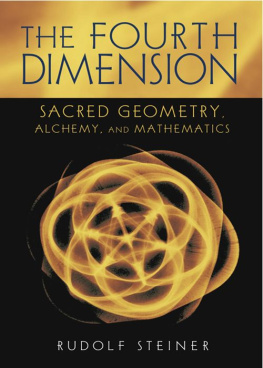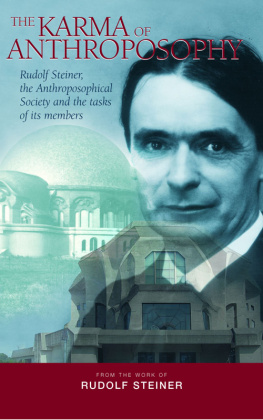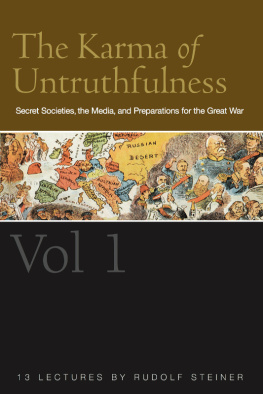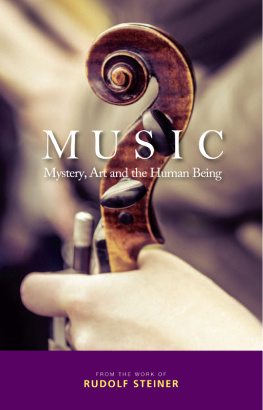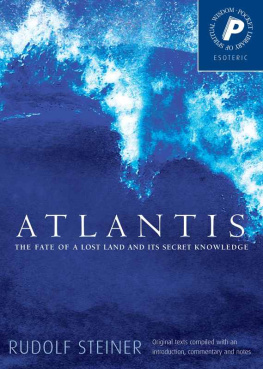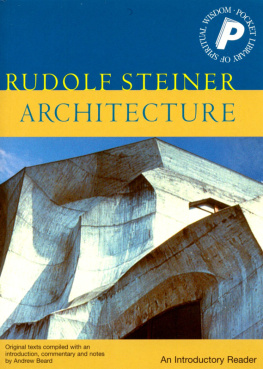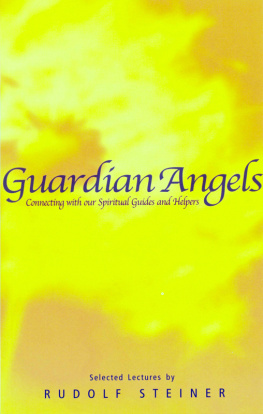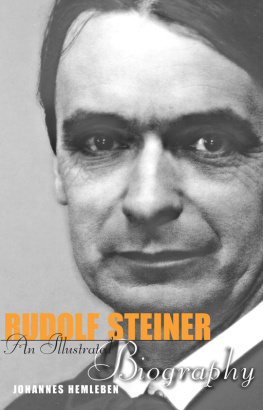

Copyright 2000 by Anthroposophic Press
A translation from the German Die vierte Dimension: Mathematik und Wirklichkeit (Vol. 324a in the Bibliographic Survey). First published 1995 by Rudolf Steiner Verlag, Dornach, Switzerland.
Translated by Catherine E. Creeger
Introduction copyright 2000 by David Booth
Published by
Anthroposophic Press
Post Office Box 799
Great Barrington, Massachusetts 01230
www.anthropress.org
Cover design by Michele Wetherbee
Book design by Paul Perlow
Library of Congress Cataloging-in-Publication Data
Steiner, Rudolf, 1861-1925.
[Vierte Dimension. English]
The fourth dimension : mathematics and reality : listeners' notes of lectures on higher-dimensional space and questions and answers on mathematical topics / Rudolf Steiner.
p. cm.
A six-lecture series held in Berlin from Mar. 24 to June 7, 1905; two single lectures given in Berlin on Nov. 7, 1905 and Oct. 22, 1908; questions and answers from 1904 to 1922.
Includes bibliographical references.
ISBN 0-88010-472-4
1. Fourth dimension (Parapsychology) 2. Anthroposophy. I. Title.
BP595.S894 V5413 2001
299'.935dc21
00-067598
10 9 8 7 6 5 4 3 2 1
All rights reserved. No part of this book may be reproduced or used in any manner without the written permission of the publisher.
Printed in the United States of America
CONTENTS
PART I
LECTURES ON THE FOURTH DIMENSION
Mathematical thinking and reality. The dimensions of space. Movement as a means of passing from lower to higher dimensions. Mirror-image symmetry. Analogies for the relationship between the outer world and internal sensation: bending ever larger line segments into circles, seal and sealing wax. The fourth dimension as a conceptual possibility and as reality. Enlivening our visualization of space: Oscar Simony's models.
Thoughts on four-dimensional space in connection with Hinton's work. Symmetrical relationships. Loops in space as real natural processes and forces, for example, the movement of the Moon and Earth around the Sun. Building up the dimensions. Human beings as four-dimensional beings; at earlier stages of our evolution, we were three-dimensional. The astral world. Point and periphery; a point radiating light outward is the opposite of a sphere radiating darkness toward the center. The cube and its opposite. Radiant ability as an additional dimension; its application to squares and cubes.
Studying four-dimensional space as preparation for understanding the astral world and other forms of higher existence. Characteristic attributes of the astral world: numbers, spatial figures, and time sequences must be read symmetrically, that is, in reverse or as their own mirror images. Morality also appears in inverted or mirror-image form. The periphery is the center. Human life as a backup in the two streams of time running from the past and the future. The threshold, as an astral experience of the panorama a future evolution, includes the question, Do you choose to enter? Kamaloka reveals the unpurified animal nature of the human being; this is the deeper meaning of the doctrine of transmigration of souls. A square on the physical and mental level. The physical square as a stoppage in two pairs of opposing streams. A cube on the physical and mental level. Positive and negative dimensions. The astral world is four dimensional. The animal as a stoppage in the opposing streams represented by the plant and the human being.
Exercises in representing three-dimensional figures in two dimensions, with reference to Hinton. Unfolding the three dimensions of a cube; using colors to represent them. Representing the third dimension in a plane by moving a bicolored square through a third color. Transferring this operation to the representation of a four dimensional figure, the tessaract. Unfolding a tessaract compared with unfolding a cube. The alchemical mystery and a true view of four-dimensional space. Meditative visualization of mercury, sulfur. Astral substance.
Unfolding a cube as a new analogy for three-dimensional representation of a tessaract (four-dimensional cube). Analogy as a method of developing a mental image of four-dimensional figures. Halving the number of surfaces in an octahedron produces a tetrahedron; this operation cannot be performed on a cube. The geometric properties of the rhombic dodecahedron compared with the cube and the tetrahedron/octahedron. The cube as the counterpart of three-dimensional space. Curved figures bounding two- and three-dimensional figures: curved squares and curved cubes. An ordinary cube is the result of flattening a curved cube. Reversing this operation and curving a three-dimensional figure can result in a four-dimensional figure.
A hexagon is the projection of a cube into two-dimensional space; a rhombic dodecahedron is the projection of a tessaract into three-dimensional space. The axes of the cube and rhombic dodecahedron. Plato's cave metaphor as an image of the relationship between four-dimensional reality and three-dimensional space. Movement or time as the expression and manifestation of life, the fourth dimension. Crystals have planes for boundaries, while living things have spherical boundaries. Destroying a living thing's fourth dimension results in a static three-dimensional image. The fifth dimension, which results from encounters between four-dimensional beings, manifests in the third dimension as sensory activity. Self-awareness is the projection of the sixth dimension into the three-dimensional physical world. What Moses experienced on Mount Sinai is an example of a real four-dimensional being with two ordinary dimensions plus the two higher dimensions of time and sensory activity. The development of spiritual abilities through intensive inner work with the analogies presented here.
Berlin, November 7, 1905
Creating dimensions through movement. Transforming a circle into a straight line. The importance of recent synthetic, projective geometry in considering space correctly. Space is self-contained. Twists in closed curves (strips of paper) as an example of intertwining dimensions. In reality, the movements of the Moon and Earth around the Sun are similarly intertwined. Enlivening our view of space. Unfolding the cube in a plane and the tessaract in three-dimensional space. A hexagon is a projection of a cube; a rhombic dodecahedron is a projection of a tessaract. The transition to reality. Time, movement, and development as expressions of the fourth dimension in plants. When time itself becomes alive, sensory ability emerges as the expression of the fifth dimension in animals. Human beings are six-dimensional beings.
Berlin, october 22, 1908
Mathematicians can do no more than discuss the possibility of higher-dimensional space. The cube's three dimensions of length, width, and height. What is a plane surface? A merely arithmetical transition to higher dimensions does not lead to reality. Attempting to understand space--for example, infinity--on the basis of numbers leads to confusion. Numbers have no relationship or a neutral relationship to space. observing repeated disappearances and reappearances points to the existence of a fourth dimension. Refuting a materialistic argument. Unfolding the boundaries of a square and a cube. Unfolding the eight cubes of a tessaract.
PART II
QUESTIONS AND ANSWERS 1906-1922
Occult schooling means working on our astral body and ether body. The astral world is four dimensional. Life reveals its fourth dimension through growth. Comparison to an ever-widening circle that becomes a straight line. Astral space is self-contained.
Next page
